Search results for: 'den'
-
 Roman oil lamp with dolphins and trident
Roman oil lamp with dolphins and tridentImpressive oil lamp with interesting maritime scene from very old German collection
Price: on request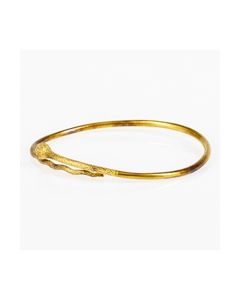 Golden circlet in the shape of a snake
Golden circlet in the shape of a snakeBeautiful piece of gold jewellery from Egypt in Roman Imperial times. Published in the exhibition catalogue of the Basel Museum of Ancient Art.
Price: on request Golden fingerring in the shape of a snake
Golden fingerring in the shape of a snakeBeautiful gold ring from Egypt in Roman Imperial times. Published in the exhibition catalogue of the Basel Museum of Ancient Art.
Price: on request Golden fingerring in the shape of a snake
Golden fingerring in the shape of a snakeBeautiful gold ring from Egypt in Roman Imperial times. Published in the exhibition catalogue of the Basel Museum of Ancient Art.
Price: on request Tonstatuette des Harpokrates aus dem Fayum
Tonstatuette des Harpokrates aus dem FayumKurze Locken, darauf Blumenkranz mit Doppelkrone und zwei seitlich in den Kranz gesteckten Lotusknospen. Die Finger der rechten Hand sind vor den Mund geführt.
Price: on request Römischer Terra Sigillata Teller aus Sfax (Tunesien)
Römischer Terra Sigillata Teller aus Sfax (Tunesien)Teller mit schräg ansteigender Wandung und nach innen geneigter Lippe. Aus alter niederländischer Sammlung, aufgebaut in den 1950er-90er Jahren.
Price: on request Ägyptische Froschlampe
Ägyptische FroschlampeDer Frosch galt bei den Ägyptern als Symbol der Auferstehung, als solches ging er auch in die christliche Symbolik ein. Museal.
Price: on request Abdruckform zur Fertigung von Öllampen - Unterseite - selten
Abdruckform zur Fertigung von Öllampen - Unterseite - seltenZur Fertigung frühchristlicher nordafrikanischer Öllampen aus rotem Ton. Museumswürdiges Stück, perfekt erhalten.
Price: on request Abdruckform zur Fertigung von Öllampen - Unterseite - selten
Abdruckform zur Fertigung von Öllampen - Unterseite - seltenZur Fertigung frühchristlicher nordafrikanischer Öllampen aus rotem Ton. Museumswürdiges Stück, perfekt erhalten.
Price: on request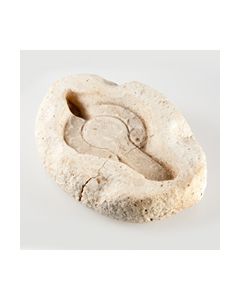 Abdruckform zur Fertigung von Öllampen - Oberseite - selten
Abdruckform zur Fertigung von Öllampen - Oberseite - seltenZur Fertigung frühchristlicher nordafrikanischer Öllampen aus rotem Ton. Im Spiegel Tiermotiv. Museumswürdiges Stück.
Price: on request Clay figurine of Harpokrates from the Fayum
Clay figurine of Harpokrates from the FayumKopf und Oberkörper einer Harpokrates-Statuette. Der rechte Arm ist vor dem Oberkörper angewinkelt, der Zeigefinger vor den Mund geführt. Großes, massives Stück.
Price: on request Abdruckform zur Fertigung von Öllampen - Unterseite - selten
Abdruckform zur Fertigung von Öllampen - Unterseite - seltenZur Fertigung frühchristlicher nordafrikanischer Öllampen aus rotem Ton. Museumswürdiges Stück, perfekt erhalten.
Price: on request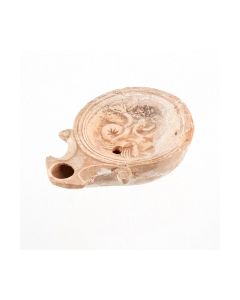 Roman volute oil lamp from Tunisia
Roman volute oil lamp from TunisiaIm Spiegel Reiter auf nach rechts fliegendem Hippogryph. Interessanter Typ aus den römischen Provinzen in Nordafrika. Anfang des 1. Jh. n. Chr.
Price: on request Großer römischer Terra Sigillata Teller aus Sfax (Tunesien)
Großer römischer Terra Sigillata Teller aus Sfax (Tunesien)Flacher Teller mit hoher konischer Wand. Sehr großes und imposantes Stück. Aus alter niederländischer Sammlung, aufgebaut in den 1950er-90er Jahren.
Price: on request Clay figurine of an Orans from the Fayum
Clay figurine of an Orans from the FayumAus dem Fayum. Kopf einer Frau mit rundem Gesicht, breiter Knollennase und wulstigem Hals. In den Ohren Löcher für Aufnahme von Ohrringen. Exzellent erhalten.
Price: on request Scarab with two cartouches of Thutmose III.
Scarab with two cartouches of Thutmose III.Interesting amulet from the New Kingdom or a later period made in archaic style. This scarab is described in the catalogue of Irène Gautier-Vodoz.
Price: on request Scarab with cartouche
Scarab with cartoucheAmulet from the Late Period. The stamp is in great condition. This scarab is described in the catalogue of Irène Gautier-Vodoz.
Price: on request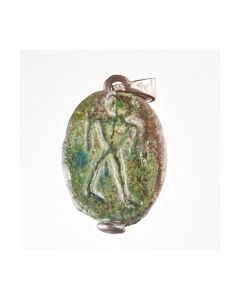 Scarab with standing figure
Scarab with standing figureThe scarab amulet dates to the Late Period. The lower side shows a stading figure, possibly the goddess Neith.
Price: on request Ägyptisches Zylindersiegel, 3.-2. Jt. v. Chr.
Ägyptisches Zylindersiegel, 3.-2. Jt. v. Chr.Zylinderförmiger Siegelkörper aus Fayence mit Taille. Die Flächen sind mit einem Ritzdekor verziert. Ex Sammlung J. Cummings.
Price: on request Ushebti für Wa-ibra-sa-Neith
Ushebti für Wa-ibra-sa-NeithGrabfigur aus Fayance, Spätzeit des Alten Ägypten, ca. 652-332 v. Chr.26. bis 30. Dynastie. Museale Erhaltung!
Price: on request Egyptian New Year flask with ornamentation
Egyptian New Year flask with ornamentationHieroglyphic inscription expressing New Year wishes for Ptah at the beginning of the nile floodings. Important 26th dynasty piece associated with the Egyptian New Year rituals. The object is a fantastic example of the skilled workmanship and artistic quality of faience in ancient Egypt.
Price: on request Scarab with breath of life
Scarab with breath of lifeThe Ankh on the bottom side of this ancient egyptian scarab symbolized life or afterlife. The symbol is framed by volutes.
Price: on request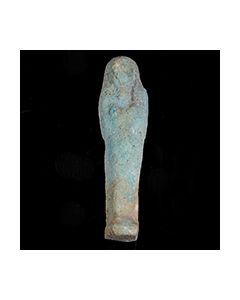 Uschebti aus der Ptolomäerzeit
Uschebti aus der PtolomäerzeitWeiß-grüne Fayence, Höhe ca. 7,4 cm, 4. Jh. v. Chr - 3. Jh. v. Chr., Ptolomäerzeit.Sehr gute Erhaltung, ausgearbeitete Gesichtszüge, vollständig intakt.
Price: on request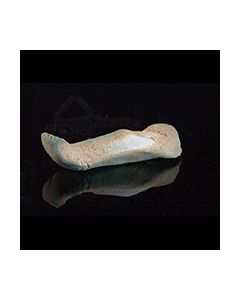 Uschebti aus der Ptolomäerzeit
Uschebti aus der PtolomäerzeitWeißlich-grüne Fayence, Höhe 5,2 cm, 4. - 3. Jh. v. Chr., Ptolomäerzeit. Faszinierendes Belegstück für die letzte Periode der klassischen ägyptischen Geschichte.
Price: on request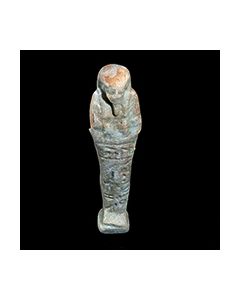 Uschebti mit hieroglyphischer Inschrift
Uschebti mit hieroglyphischer InschriftGrüne Fayence mit Hieroglyphen, ca. 10cm groß, intakt und nicht restauriert. 664 v. Chr. - 525 v. Chr., 26. Dynastie, Beginn der Spätzeit.
Price: on request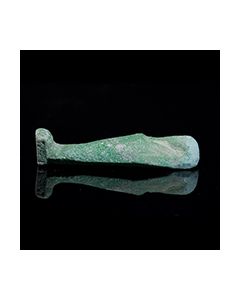 Uschebti aus der Ptolomäerzeit
Uschebti aus der PtolomäerzeitGrüne Fayence, intensive Farbe der Glasur, sehr schöne Züge. Vollständig intakt, nicht restauriert. Ptolomäerzeit, 4.- 3. Jh. v. Chr.
Price: on request Ushabti-Figur, hellgrüne Fayence
Ushabti-Figur, hellgrüne FayenceIntensiv kolorierte Figur mit schwarzem Ständer, Ägypten, Spätzeit
Price: on request Prachvoller Ushebti mit Hieroglyphen
Prachvoller Ushebti mit HieroglyphenDetailliert gearbeitete Figur mit vollständig erhaltener, stellenweise noch glänzender Glasur und Hieroglyphen auf der Rückseite.
Price: on request Große Ushabti-Figur
Große Ushabti-FigurInteressanter Ushebti in perfekter Erhaltung, detailliert gearbeitet, Ägypten, Spätzeit, 26. Dynastie
Price: on request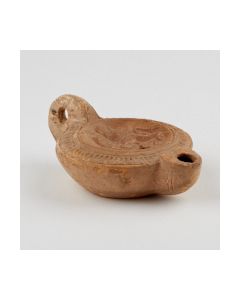 Roman oil lamp with imperial equestrian statue
Roman oil lamp with imperial equestrian statueImpressive, perfectly preserved lamp from old German collection
Price: on request Uschebti, ägyptische Totenfigur
Uschebti, ägyptische TotenfigurSchöne mintgrüne Fayence, erkennbare Gesichtszüge. Höhe 85mm. 26. - 30. Dynastie, Spätzeit.
Price: on request Egyptian ushabti for Ra-mes
Egyptian ushabti for Ra-mesThe mummiform funerary figurine dates to the Late Period of ancient Egypt, 26th to 31st dynasty. It is remarkable that it probably originates from the burial of two brothers, Ra-mes and Somtus-tefnacht.
Price: on request Ushabti for Ra-mes
Ushabti for Ra-mesThe mummiform funerary figurine dates to the Late Period of ancient Egypt, 26th to 31st dynasty. It is remarkable that it probably originates from the burial of two brothers, Ra-mes and Somtus-tefnacht.
Price: on request Egyptian ushabti for Somtus-tefnacht
Egyptian ushabti for Somtus-tefnachtThe mummiform funerary figurine dates to the Late Period of ancient Egypt, 26th to 31st dynasty. It is remarkable that it probably originates from the burial of two brothers, Somtus-tefnacht and Somtus-tefnacht.
Price: on request Egyptian ushabti for Somtus-tefnacht
Egyptian ushabti for Somtus-tefnachtThe mummiform funerary figurine dates to the Late Period of ancient Egypt, 26th to 31st dynasty. It is remarkable that it probably originates from the burial of two brothers, Somtus-tefnacht and Somtus-tefnacht.
Price: on request Egyptian ushabti for Somtus-tefnacht
Egyptian ushabti for Somtus-tefnachtThe mummiform funerary figurine dates to the Late Period of ancient Egypt, 26th to 31st dynasty. It is remarkable that it probably originates from the burial of two brothers, Somtus-tefnacht and Somtus-tefnacht.
Price: on request

